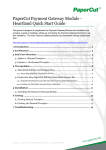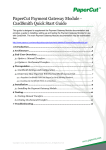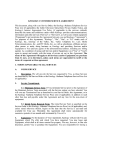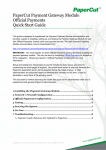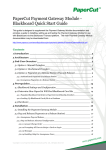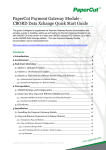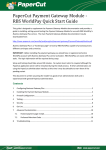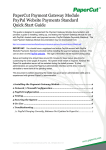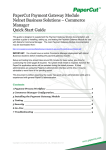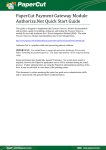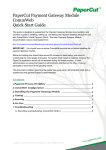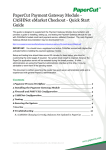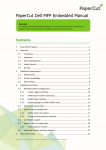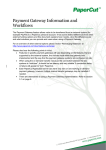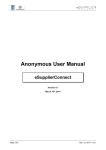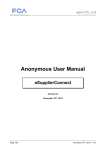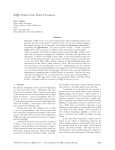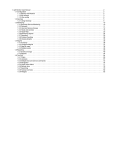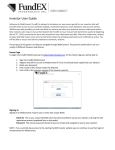Download PaperCut Payment Gateway Module
Transcript
PaperCut Payment Gateway Module CBORD Quick Start Guide This guide is designed to supplement the Payment Gateway Module documentation and provides a guide to installing, setting up, and testing the Payment Gateway Module for use with the CBORD Odyssey system. The main Payment Gateway Module documentation may be downloaded from: http://www.papercut.com/anonftp/pub/pcng/ext/payment-gateway/PaymentGatewayModule.pdf This document is written assuming the reader has good server administration skills and is experienced with general PaperCut administration. PaperCut should be configured, installed and tested before installing the Payment Gateway Module with CBORD support. Contents 1 Introduction .................................................................................................................................... 2 2 Architecture .................................................................................................................................... 2 3 End-User Overview ......................................................................................................................... 3 4 Prerequisites ................................................................................................................................... 6 4.1 CBORD settings and configuration .......................................................................................... 6 4.2 Mapping network users to CBORD ID numbers ...................................................................... 6 4.2.1 Use the PaperCut ID number field (default) ................................................................... 7 4.2.2 Lookup in external database ........................................................................................... 7 4.3 5 6 Choose transfer mode ............................................................................................................ 7 Installation ...................................................................................................................................... 8 5.1 Installing the Payment Gateway Module................................................................................ 8 5.2 Testing ..................................................................................................................................... 9 5.2.1 Testing the Manual transfer mode ................................................................................. 9 5.2.2 Testing the on-demand/auto transfer ............................................................................ 9 Handling Guest Users and Anonymous Cards............................................................................... 11 6.1 Automatic self-registration at Release Stations.................................................................... 11 6.2 Manual Creation ................................................................................................................... 11 7 Troubleshooting ............................................................................................................................ 12 8 Planned Features and Known Limitations .................................................................................... 13 PaperCut Payment Gateway Module - CBORD Quick Start Guide 1 Introduction CBORD is a popular one-card payment system used in many college campuses throughout the world. CBORD allow people to pay for on-campus services using their CBORD credit/account. The PaperCut CBORD payment gateway allows PaperCut to integrate with CBORD to allow students to pay for printing from their CBORD account. Key Feature Summary Automatic integration with CBORD – no hardware dependence No need for the user to leave their computers to conduct a deposit/transfer Different operation modes: o End-user instigated transfer o Automatic transfer on-demand (Live) o Automatic transfer on-demand (Batched amount) Combination thereof as set by administrator Administrator control configuration options Full transaction auditing for both end-user and administrators Live integration with Active Directory (if secure) and/or an external database to facilitate associated of network login identities with CBORD accounts/cards Implementation does not compromise/replace standard PaperCut features such as free quotas, overdraft rules, or the ability to add alternate payment types in the future (e.g. PayPal, Credit Card, Loan Systems, etc.). 2 Architecture The solution is designed with security as the number one objective. All communication with CBORD (and external credit source) is done via the PaperCut Server. No client software is used. Communication with end-users is encrypted using SSL/TLS Browser encryption. Setup and testing time should take around 30 minutes. No system level restart is required; however the PaperCut application server will be restarted during the install process. If other administrators are using the PaperCut administration interface at this time, it may be advisable to warn them of the pending restart. Copyright © 2013 PaperCut Software International Pty. Ltd., All Rights Reserved 2 of 13 PaperCut Payment Gateway Module - CBORD Quick Start Guide This document is written assuming the reader has good server administration skills and is experienced with general PaperCut administration. 3 End-User Overview The system may be configured in one of three operating modes. The operating mode is configured by the administrator. Mode 1: Manual Transfer Mode In this mode users instigate a payment/transfer manually direct from their desktop using the PaperCut End-User Web interface. The interface and workflow will be based on the proven interface used for other payment gateway interfaces including the popular PayPal and CyberSource systems used by many organizations. 1. The user logs into the standard PaperCut. 2. A new “Add Credit” link existing on the left (The link will appear after the module is installed. The name of the link can be changed). 3. The user clicks “Add Credit” and select the amount to transfer (the range of amounts can be defined by the administrators). 4. After clicking the form Submit button, the selected amount, if available, is placed in the user’s account in real time. 5. The end-user can view and report on all details of their historic transactions via the web interface. These screen-shots show the equivalent end-user screens currently live at an equivalent system at Harvard University. Attributes such as visual design, link names, and instruction/help text can all be customized. Copyright © 2013 PaperCut Software International Pty. Ltd., All Rights Reserved 3 of 13 PaperCut Payment Gateway Module - CBORD Quick Start Guide Figure 1: Interface accessed via standard end-user PaperCut login (can be skinned to organization design) Figure 2: Extra option(s) above normal options after gateway is installed. Figure 3: Conducting a transfer: What the end-user sees. Interface options can be configured by administrator. Copyright © 2013 PaperCut Software International Pty. Ltd., All Rights Reserved 4 of 13 PaperCut Payment Gateway Module - CBORD Quick Start Guide Mode 2 & 3: On-Demand Mode (Live or Batched Transfer) In this mode, the system will automatically transfer funds from CBORD to the user’s PaperCut account on an as-need basis based on rules defined by the Administrator. For example, if a user performs printing when they have no PaperCut printing credit, the PaperCut CBORD integration will automatically transfer a defined amount, or the cost of the job, into the user’s PaperCut account to pay for the print job. By default only the amount required for the current print job is transferred. This leaves the user with a zero PaperCut balance after the cost of the print job is deducted. This is known as “Live Mode” where there is a one-to-one link between a print job requiring funds and a transaction in the CBORD system. CBORD recommend live mode. The other on-demand transfer mode is batched mode where a fixed pre-determined amount is transfer into the user’s account as required (i.e. the user runs out of funds). The default transfer amount is defined by the administrator. Each on-demand mode offers different advantages and compromises. Live mode ensures funds never remain in the PaperCut account and hence could potentially be used elsewhere by the user. Batch mode on the other hand partly decouples PaperCut from the CBORD system offering advantages around reliability and scalability: 1. Batch mode reduces the number of transactions sent to the CBORD system. 2. If the CBORD system or the network link is down, printing for most users can continue and downtime would only affect users who require CBORD credit at this time. These modes are best illustrated by examples: Example of live mode: 1. User Betty only has $0.00 in her PaperCut printing account. 2. Betty prints a job that costs $3.50. 3. The PaperCut CBORD gateway transfers the required $3.50 into Betty’s PaperCut account. Example of batch mode with a $5.00 default transfer amount: 1. User Betty only has $0.50 in her PaperCut printing account. 2. Betty prints a job that costs $3.50. Copyright © 2013 PaperCut Software International Pty. Ltd., All Rights Reserved 5 of 13 PaperCut Payment Gateway Module - CBORD Quick Start Guide 3. Because the print job costs more than the value currently in her account, the PaperCut CBORD gateway transfers the default transfer amount of $5.00. 4. The job cost is deducted from the PaperCut account leaving Betty with $1.50 in her PaperCut account which may be used for future printing. The on-demand transfer mode is enabled and configured by the administrator. No end-user intervention is required. End users however have a full list of all transfers available from their EndUser web interface. If using batch mode, sites should explain to users how the system works (e.g. default transfer amounts). Notes: On-demand mode can be configured to only apply to a group of users (e.g. Students and not staff) Any free quota allocated to users is used first before the CBORD system is contacted for value. May be used to implement a predictable system where a fixed amount is transferred each time (e.g. $5 blocks). Or may be configured to simply transfer the value of each job on demand. If the user is out of CBORD funds the “inadequate credit” message will propagate to the user as it normally does in PaperCut (options include popup message or email notification). Both Mode 1, or 2 and 3 (on-demand) can be enabled together offering a flexible hybrid system, or the group-level restrictions may be used to enable one mode for one group of users and another mode for another group. 4 Prerequisites This section describes the prerequisites before the payment gateway module can be installed. 4.1 CBORD settings and configuration CBORD Odyssey must be configured to allow PaperCut to perform transactions. This requires that a PaperCut “terminal” to be created in CBORD. Please contact CBORD for this information. The payment gateway module requires the following information about your CBORD setup: CBORD server network address CBORD server port (default: 3785) Terminal address. This is a 2 digit number used to identify PaperCut to the CBORD system. By default PaperCut uses “01”, however this can be changed to suit the site. Tender number – the CBORD tender that PaperCut will deduct funds from (default: 3) The settings are configured in the payment gateway configuration file. 4.2 Mapping network users to CBORD ID numbers The payment gateway requires a user’s CBORD ID number to perform a transaction from their CBORD account. This requires a mapping between PaperCut users (e.g. a network domain Copyright © 2013 PaperCut Software International Pty. Ltd., All Rights Reserved 6 of 13 PaperCut Payment Gateway Module - CBORD Quick Start Guide username) and CBORD ID. CBORD has two user ID’s. One is a Card number and the other a user ID number. PaperCut’s CBORD interface has been designed to support either/or. In PaperCut, users are identified by their network username. This differs from CBORD where a CBORD ID (or Card number) is used to identify a user. The two must be linked together via a mapping method. The PaperCut CBORD payment gateway allows for a number of mapping options (described below). The settings for the ID lookup are found in the payment gateway configuration file in the section. e.g. “cbord.id-lookup.mode”. If you have questions about the ID mapping, please contact PaperCut support. 4.2.1 Use the PaperCut ID number field (default) In this lookup mode the number stored in the “Card/ID field” for the user in PaperCut is used for CBORD transaction. This is number may be automatically imported from Active Directory or LDAP, or alternatively imported from a text file. Information about importing the ID numbers into PaperCut can be found in the PaperCut Manual in the section titled “Importing Card/Identity numbers from Active Directory or LDAP”. This approach is generally suitable for sites that store users’ CBORD numbers in fields in their existing Active Directory or LDAP server. 4.2.2 Lookup in external database Many CBORD sites maintain a database mapping CBORD ID numbers to network usernames. The PaperCut CBORD gateway can be configured to lookup a user’s CBORD ID in an external database. To do this you will require: The lookup data in an external database server (we recommend Microsoft SQL Server, Oracle or PostgreSQL). Connection details for the database (e.g. network address, database name, and username/password, etc). NOTE: Only read-only access to the database is required. A SQL query that will return the user’s CBORD ID number given a username (or other user details). This lookup mode can be enabled by changing the “cbord.id-lookup.mode” setting to “EXTERNAL_DATABASE” in the CBORD gateway configuration file. For detailed configuration instructions, see the config file. 4.3 Choose transfer mode The payment gateway offers alternate transfer modes as described in section 3 “End-User Overview” above, including: Manual transfer – the user initiates the transfer and selects the amount. This mode is the simplest for users to understand and give the user full control over the funds they transfer from CBORD into PaperCut. On-demand (Live or Batched transfer) – the gateway will automatically transfer funds when required for printing. This mode requires no end-user interaction. This is setting is configured using the “cbord.mode” setting in the config file. Copyright © 2013 PaperCut Software International Pty. Ltd., All Rights Reserved 7 of 13 PaperCut Payment Gateway Module - CBORD Quick Start Guide 5 Installation This document is written assuming the reader has good server administration skills and is experienced with general PaperCut administration. Setup and testing time should take around 30 minutes. No system level restart is required; however the PaperCut application server will be restarted during the install process. If other administrators are using the PaperCut administration interface at this time, it may be advisable to warn them of the pending restart. 5.1 Installing the Payment Gateway Module 1. The Payment Gateway Module will function during the PaperCut NG 40 day trial period. After this, the module must be licensed. If you have been supplied with a new license take the time to install this now. The license install procedure is documented in the PaperCut user manual chapter ‘Licensing and Support’. 2. Download the Payment Gateway Module from the PaperCut website at http://www.papercut.com/anonftp/pub/pcng/ext/payment-gateway/pcng-paymentgateway-module.exe 3. Install the module into the same directory as PaperCut NG. This is normally: C:\Program Files\PaperCut NG 4. Open the file: [app-path]\server\lib-ext\payment-gateway-cbord.properties in a text editor such as Notepad. 5. Locate the line cbord.enabled=N and change the N to Y. This will enable the CBORD module. 6. Locate the line cbord.server.hostname and enter the network address of your CBORD server. 7. Verify that the cbord.server.port setting is correct for your CBORD instance. 8. Locate the line cbord.server.terminal-address and enter the 2 digit terminal address assigned to “PaperCut” in CBORD. By default this is set to “01”. 9. Locate the line cbord.server.tender-number and enter the tender number (1-9) that PaperCut will deduct funds from. 10. Select and configure your chosen CBORD ID lookup mode (configuration item: cbord.idlookup.mode). This is discussed in more detail in Section 4.2 “Mapping network users to CBORD ID numbers” above. Copyright © 2013 PaperCut Software International Pty. Ltd., All Rights Reserved 8 of 13 PaperCut Payment Gateway Module - CBORD Quick Start Guide 11. Take some time to review the configurable options available in the payment-gatewaycbord.properties file. Options include limits on the amount to transfer, access groups and custom error messages. You may like to enable a group restriction to limit access to administrators until configuration is complete. 12. Save the file and exit the text editor. 13. Restart the PaperCut Application Server service via Control Panel -> Administrative Tools -> Services and wait 30 seconds. 5.2 Testing The Payment Gateway Module for CBORD is now ready for testing. This test will involve performing a live transaction with the CBORD system, testing real-world end-to-end functionality. To begin testing you will require a login for a user that has an associated account in CBORD. The simplest way to achieve this is to enter a test CBORD ID in the “Card/ID number” field of your test user in the PaperCut administration interface. 5.2.1 Testing the Manual transfer mode (Only if manual transfer is enabled) 1. Log into the PaperCut user web interface at http://papercut:9191/user 2. A new link called Add Credit should appear on the left. Click this link. 3. Select and amount to add and press Continue. 4. The requested amount will be transferred from the user’s CBORD account into PaperCut. The transaction can be viewed in the “Transaction History”. 5.2.2 Testing the on-demand/auto transfer (Only if on-demand/auto transfer is enabled) 1. Login to the PaperCut admin interface (http://papercut:9191/admin) and select your test user from the Users tab. 2. Change the user’s account balance to $0.0. 3. Login to a workstation as this test user and perform a test print job. Copyright © 2013 PaperCut Software International Pty. Ltd., All Rights Reserved 9 of 13 PaperCut Payment Gateway Module - CBORD Quick Start Guide 4. The print job should trigger a transfer of credit from CBORD and the print job should be allowed. 5. Login to the PaperCut admin interface and select the test user from the Users tab. 6. Select the user’s Transaction History tab, where you should see the funds transferred from CBORD into PaperCut (and then the deducted from PaperCut for the cost of the print job). Copyright © 2013 PaperCut Software International Pty. Ltd., All Rights Reserved 10 of 13 PaperCut Payment Gateway Module - CBORD Quick Start Guide 6 Handling Guest Users and Anonymous Cards PaperCut supports guests via its Internal Users feature. Internal users are accounts that only exist in the PaperCut database and not in the network domain/directory (e.g. Active Directory). This feature allows organizations to support guest users without having to pollute their network directory with temporary guest accounts. The Internal Users feature is documented in detail in Chapter 24. The key is to ensure that the internal CBORD account/card is associated with the internal users in PaperCut. It is able to do this in using one of two modes. 6.1 Automatic self-registration at Release Stations The PaperCut full-screen software based release station may be configured to support authentication via Swipe Card by using USB based swipe card readers. A reader compatible with CBORD cards can be used to facilitate self registration at a release station. The setup and process would work as follows: Setup Requirements: Guests print to a separate set of print queues configured to use hold/release queues The full-screen software based release station is setup on station(s) next to the printers. The release station is configured to use card authentication via a compatible USB based card reader (e.g. Magtek ) The internal user’s feature is enabled in PaperCut. The release station should be configured in release-any mode and enable-card-selfregistration feature is set to “Y” in the release station config.properties file. The CBORD interface is configured to use “On Demand” mode, or at least “On Demand” for the [Internal Users] group. Guest User Procedure: 1. A guest user is allocated an anonymous CBORD card. 2. The user logs into a computer and prints to the queues set up for guest users. 3. They walk up to a release station and swipe their card. 4. An account matching this account can’t be found so the system asks if a new should account be created. The user clicks “yes”. 5. An internal user account is created and associated with the supplied card number. 6. The user may release their job. Any job released will be charged to the CBORD card. 7. The user may continue to use their card. The user will not be prompted to create an account on subsequent release station login as it’s already registered. 6.2 Manual Creation Internal Users may also be manually created either via the PaperCut administration web interface or via a text file import. After an internal user is created, it may be associated with a CBORD card number by simply putting the CBORD card number in the “Card/Identity Number” field in the PaperCut interface. Copyright © 2013 PaperCut Software International Pty. Ltd., All Rights Reserved 11 of 13 PaperCut Payment Gateway Module - CBORD Quick Start Guide This internal user account may now be used with any CBORD operating mode (e.g. Live or Manual) using any authentication method supported by PaperCut. These include: Popup Authentication at the time of print Via a Release Station Note: Both the automatic self-registration and manual methods store the CBORD card number in the PaperCut database. It is still possible to use an external mapping source (e.g. a database or Active Directory) for non-guest users. The CBORD interface has been designed to “fall back” to using the PaperCut database Card/Identity Number if the card does not exist in the external mapping source and the user account is an Internal User. Management of guest users is a complex topic! We have designed PaperCut to be as flexible as possible so implementations can be tailor to existing procedures and policies. This flexibility also brings complexity. Network administrators will need to invest some “thought power” into experimentation, design, testing and user-education. The PaperCut development team, or authorized reseller will be able to assist. 7 Troubleshooting 7.1 Receiving error “CARDSWIPE ONLY” This error indicates that the terminal configuration in CBORD has been configured to disallow “keyboarded” ids (meaning only swiped cards are accepted). PaperCut sends transactions to CBORD indicating that the number may either be an id or swiped card number. If CBORD determines that the number is an id, but the terminal is configured to disallow ids, the above error is retured. To resolve this issue simply configure the terminal to allow “keyboarded” id entry, or contact your CBORD account manager for assistance. 7.2 Other Problems Administrators may find information in the following log files useful when trying to troubleshoot setup/configuration problems or issues reported by end-users. Payment Gateway Event Log: [app-path]\server\logs\payment-gateway\event.log This log contains gateway specific error messages and events. Copyright © 2013 PaperCut Software International Pty. Ltd., All Rights Reserved 12 of 13 PaperCut Payment Gateway Module - CBORD Quick Start Guide Application Log: [app-path]\server\logs\server.log This log contains general application specific error messages and events. Transaction Log: [app-path]\server\logs\payment-gateway\transaction.log This log contains a list of successful transactions in a tab-delimited form. Please feel free to contact the PaperCut Software Development Team at [email protected] if you require assistance. 8 Planned Features and Known Limitations The following features have been spec’ed and are intended for future inclusion if customer demand exists: Ability to allow end users to set their own settings: o Turn on/off auto transfer or on-demand modes (e.g. opt out because I’d just like to use my free quota only) o Set user specific auto transfer amounts and triggers Ability to be able to view the CBORD account balance within the client software (at the moment it only shows PaperCut balance) Ability to set upper limits per transaction. E.g. prevent users from anciently clearing out their account in one job. Support to connect to the CBORD CS Gold system (slightly different protocol) If you are interested in these features, please make your interest known to the PaperCut development team. All our features are implemented and ranked based on customer votes. Copyright © 2013 PaperCut Software International Pty. Ltd., All Rights Reserved 13 of 13













